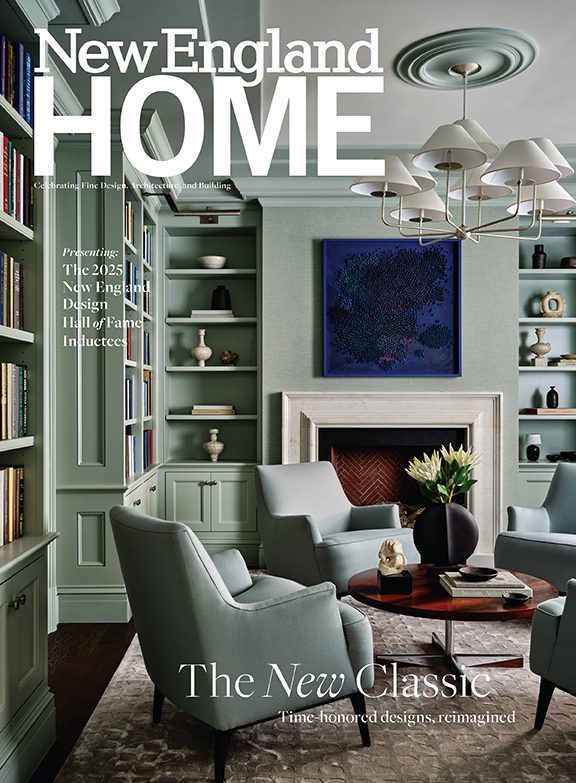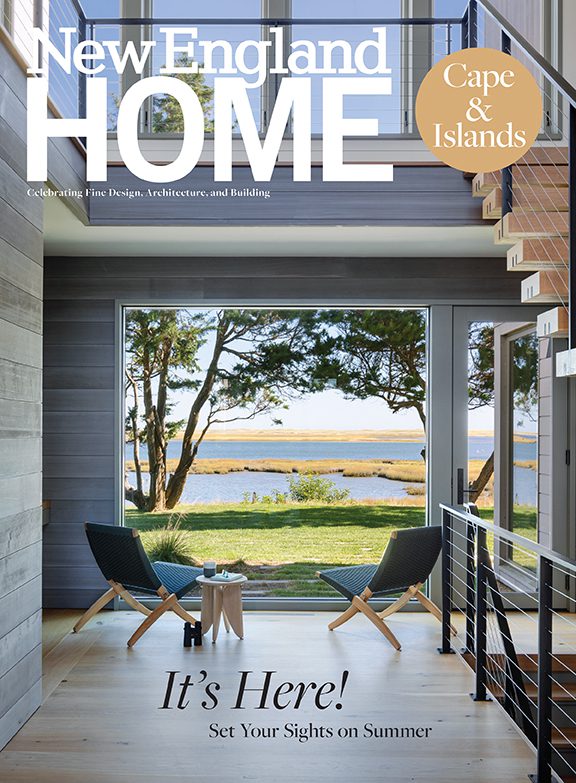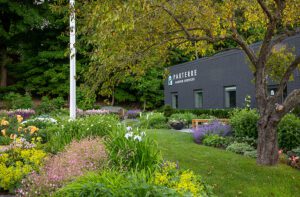Graying Gracefully
November 13, 2012
Text by Stacy Kunstel Photography by Bjorn Wallander
One of the most outrageous design oxymorons out there, after decorative modern, might just be sexy colonial. Devoid of drama or sleekness, the typical center-hall colonial can be the architectural equivalent of oatmeal: comforting and sustaining but hardly exciting.
Few talents could have managed the transformation of such a space from its suburban groundings into something so urbane, but in the hands of Mar Silver, this home in Westport reinterprets every idea of family living today.
What started out as a small interior renovation for a family with two young children turned into a two-year, front-to-back, floor-to-ceiling transformation. While the layout stayed basically the same—the very definition of colonial with an entry staircase, formal living and dining rooms, second-floor bedrooms and a kitchen that opens to a large family room—in the end, no wall or ceiling went untouched.
“I see everything architecturally first,” says Silver, a Westport-based designer. “I start by thinking about how the walls play into each other and how art is going to fit on the walls.” Throughout the house she contemporized all the moldings and doors, simplifying them to modernize the spaces.
She also dropped or reconfigured ceilings in a number of rooms, including the hallways, which she articulated as a series of inverted trays with cove lighting downstairs and lower soffits upstairs. “Dropping the ceiling makes the house so much cozier,” she says. Not only cozy, but cocoon-like in terms of the simplified interior architecture, the custom-designed silk rugs that anchor every room, the thick mohair covering the furniture and the warm gray palette of the entire house.
For many designers, contemporizing a space would mean painting it white and eliminating most ornamentation and accessories, but for Silver it was about adding just the right color. Shades of gray in a combination of tones coat each room, while woodwork is either painted or stained Silver’s signature gray hue. The colors unify the house beautifully, enveloping the spaces in moth-wing softness. “For me, gray is more soothing than stark white,” the designer says. “Grays look beautiful with woods.”
With this color scheme, “The home has a little more drama,” says Silver. “It’s a bit more moody. I think the grays we selected are warm rather than cold. Moving slightly in the tone makes the space—one soft gray flows into the next.”
The dramatic motif starts at the front door, where Silver enlarged the entry into a sitting room and updated the stairwell by cladding it in gray-stained oak and sheets of glass. “When I think about colonial it’s the dark stain that’s the eyesore for me,” says Silver. “It’s so busy. The whole approach to this house is to be architectural, but soothing and calm. I wanted to make the two-level entry a lot sexier, but at the same time adding wood, which adds mass and grounds the space. The glass keeps it from being too heavy.”
From the foyer the eye is drawn to a sitting area, where a quartet of chairs covered in pony hide surrounds a low coffee table. All are from Plunk, Silver’s own furniture line, and the chairs echo the stained oak paneling in the entry.
In the formal dining room to the left of the foyer, Silver blew out the walls and replaced them with sliding glass panels framed in wood. Offsetting the Deco-era crystal chandelier and modern art is a giant petrified wood bowl sitting atop a table made from an antique chestnut washing bin. It’s the type of juxtaposition that Silver repeats in a number of rooms, mixing the organic with the industrial and refined.
Her own path to becoming a designer is as atypical as her work. She started out in the antiques business, importing and selling to the trade. Her design career took off around 2000 as her customers began asking her to go to their clients’ homes to consult on antiques and art. “I’ve been collecting art since I was sixteen,” she says. “I have a huge love of art.”
Silver is still a collector. A number of art and furniture pieces in the house had lingered in one of her four or five storage units. “As I travel I collect lots of things and keep them in my inventory,” she explains. “When I find the right place for it, I bring it out.”
One such piece graces the living room. Two long, white sofas sit facing one another in front of the fireplace, but it is a walnut secretary against a gray wall that garners most of the attention.
Silver’s other vintage finds include a massive glass-topped Lucite desk used in the wife’s upstairs office. The designer added barn wood to one wall of the office, which also features a Matteograssi chair and a handwoven rug from Nepal. As in other rooms of the house, one of the first words that comes to mind is sumptuous.
Mohair, acrylic, midcentury modern furniture and the gray theme all combine to make seriously sexy spaces. Even the functional family room, with its large flat-screen TV, paneled fireplace wall and sectional sofa, exudes a luxe vibe.
Still, there was room to push the envelope. In the first-floor media room, Silver pumped up the color quotient of the wooden jewel box of a space with a super-high-gloss lacquered ceiling and details in a mouthwatering plum. Walnut paneling encases a pair of Roberto Dutesco horse prints while the rest of the room is about comfort—down pillows and sofa wrapped in thick silk mohair and a leather ottoman large enough to hold the stockinged feet, drinks and popcorn of the whole family.
“We wanted to do a media room with a wood paneling, but not a traditional media room,” says Silver. “Lacquering the ceiling and wall gave a contemporary edge to the room. It’s a nice balance. It’s not so dark and heavy. The lacquer reflects and lights the walnut paneling.”
It’s certainly not what one would expect to find in a colonial, but the unexpected trumps the typical in this classic house with a sophisticated twist. •
Interior Design: Mar Silver
Share
![NEH-Logo_Black[1] NEH-Logo_Black[1]](https://b2915716.smushcdn.com/2915716/wp-content/uploads/2022/08/NEH-Logo_Black1-300x162.jpg?lossy=1&strip=1&webp=1)


















You must be logged in to post a comment.